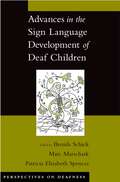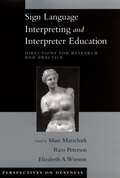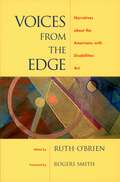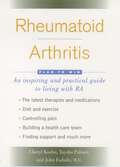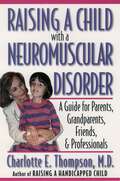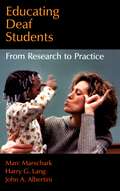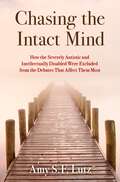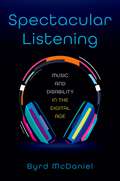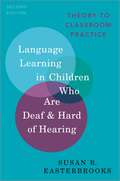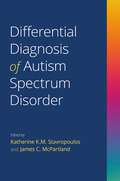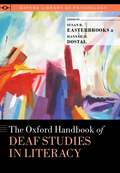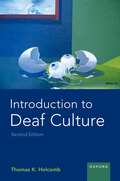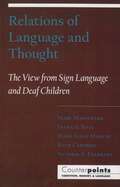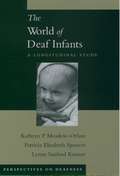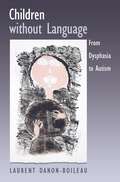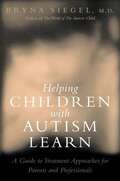- Table View
- List View
The Future of Disability Law in India: A Critical Analysis of the Persons with Disabilities (Equal Opportunities, Protection of Rights and Full Participation) Act 1995
by Jayna KothariAccording to some estimates, there are around 20 to 60 million people with disability in India. For long this invisible minority went without any kind of protection or even legislation aimed at recognizing their basic rights. It was only in 1995 that the government passed the Persons with Disabilities (PWD) Act, which addressed the issues of non-discrimination, right to equal opportunity, and affirmative action for persons with disabilities for the first time. This book is a critical and comprehensive analysis of the PWD Act. It examines the Act from a historical perspective, giving an overview of the various legal approaches towards addressing disability-related discrimination. The author critically examines the various provisions of the Act—the definition of disability, affirmative action, equal opportunities in education, reservation in employment, and implementation. The volume also offers an international perspective on disability law by comparatively analysing Indian disability law with international jurisprudence. Taking into account the judgments of the Supreme Court and various high courts, it presents a forward thinking interpretation of the Act in light of the UN Convention on the Rights of Persons with Disabilities which India has ratified.
Advances in the Sign Language Development of Deaf Children (Perspectives on Deafness)
by Brenda Schick Marc Marschark Patricia Elizabeth SpencerThe use of sign language has a long history. Indeed, humans' first languages may have been expressed through sign. Sign languages have been found around the world, even in communities without access to formal education. In addition to serving as a primary means of communication for Deaf communities, sign languages have become one of hearing students' most popular choices for second-language study. Sign languages are now accepted as complex and complete languages that are the linguistic equals of spoken languages. Sign-language research is a relatively young field, having begun fewer than 50 years ago. Since then, interest in the field has blossomed and research has become much more rigorous as demand for empirically verifiable results have increased. In the same way that cross-linguistic research has led to a better understanding of how language affects development, cross-modal research has led to a better understanding of how language is acquired. It has also provided valuable evidence on the cognitive and social development of both deaf and hearing children, excellent theoretical insights into how the human brain acquires and structures sign and spoken languages, and important information on how to promote the development of deaf children. This volume brings together the leading scholars on the acquisition and development of sign languages to present the latest theory and research on these topics. They address theoretical as well as applied questions and provide cogent summaries of what is known about early gestural development, interactive processes adapted to visual communication, linguisic structures, modality effects, and semantic, syntactic, and pragmatic development in sign. Along with its companion volume, Advances in the Spoken Language Development of Deaf and Hard-of Hearing Children, this book will provide a deep and broad picture about what is known about deaf children's language development in a variety of situations and contexts. From this base of information, progress in research and its application will accelerate, and barriers to deaf children's full participation in the world around them will continue to be overcome.
Sign Language Interpreting and Interpreter Education: Directions for Research and Practice (Perspectives on Deafness)
by Elizabeth A. Winston Patricia Sapere Carol M. Convertino Rosemarie Seewagen Christine Monikowski Marc Marschark Rico PetersonMore the 1.46 million people in the United States have hearing losses in sufficient severity to be considered deaf; another 21 million people have other hearing impairments. For many deaf and hard-of-hearing individuals, sign language and voice interpreting is essential to their participation in educational programs and their access to public and private services. However, there is less than half the number of interpreters needed to meet the demand, interpreting quality is often variable, and there is a considerable lack of knowledge of factors that contribute to successful interpreting. Perhaps it is not surprising, then, that a study by the National Association of the Deaf (NAD) found that 70% of the deaf individuals are dissatisfied with interpreting quality. Because recent legislation in the United States and elsewhere has mandated access to educational, employment, and other contexts for deaf individuals and others with hearing disabilities, there is an increasing need for quality sign language interpreting. It is in education, however, that the need is most pressing, particularly because more than 75% of deaf students now attend regular schools (rather than schools for the deaf), where teachers and classmates are unable to sign for themselves. In the more than 100 interpreter training programs in the U.S. alone, there are a variety of educational models, but little empirical information on how to evaluate them or determine their appropriateness in different interpreting and interpreter education-covering what we know, what we do not know, and what we should know. Several volumes have covered interpreting and interpreter education, there are even some published dissertations that have included a single research study, and a few books have attempted to offer methods for professional interpreters or interpreter educators with nods to existing research. This is the first volume that synthesizes existing work and provides a coherent picture of the field as a whole, including evaluation of the extent to which current practices are supported by validating research. It will be the first comprehensive source, suitable as both a reference book and a textbook for interpreter training programs and a variety of courses on bilingual education, psycholinguistics and translation, and cross-linguistic studies.
Voices from the Edge: Narratives about the Americans with Disabilities Act
by Ruth O'Brien Rogers M. SmithFear, rage, courage, discrimination. These are facts of everyday life for many Americans with disabilities. The Americans with Disabilities Act (ADA), has made working, traveling, and communicating easier for many individuals. But what recourse do individuals have when enforcement of the law is ambiguous or virtually nonexistent? And how will its changing definition affect individuals' lives-as well as their legal actions-in the future? What is life like in post-ADA America? Voices from the Edge seeks to challenge the mindset of those who would deny equal protection to the disabled, while providing informative analysis of the intent and application of the ADA for those who wish to learn more about disability rights. Giving voice to the many types of discrimination the disabled face--at a small Southern College, in the Library of Congress, on a New York City sidewalk--while illustrating the personal stakes underlying legal disputes over the ADA, this collection offers unparalleled insight into the lives behind the law. Contributors: Joan Aleshire on disability and the eye of the beholder. Achim Nowak on disclosing HIV. C.G.K. Atkins on being an academic liability. Stephen Kuusisto on hope without the tenure lifeboat. Leonard Kriegel on wheelchairs vs. NYC sidewalks. John Hockenberry on trying one's luck at public transit. Joan Tollifson on a license to drive disabled. Shawn Casey O'Brien on the blue beacon of accessibility. Jean Stewart on sign language in the ER. Ruth O'Brien on everything you wanted to know about the ADA.
Rheumatoid Arthritis: Plan to Win
by Cheryl Koehn Taysha Palmer John Esdaile M.D.Nearly 3 million Americans suffer from rheumatoid arthritis, a painful, incurable connective-tissue disease that attacks the hands and feet as well as the joints and may lead to deformities and permanent disabilities. Rheumatoid Arthritis: Plan to Win offers an inspiring, scientifically based game plan for minimizing the effects of this chronic illness, and ultimately, achieving optimal health. Here is the definitive resource for practical strategies and emotional support, whether you need help controlling pain, are concerned about medication side-effects, or want to locate a reliable RA news source or support group on the Internet. Helpful chapters detail the latest therapies, special dietary and exercise needs of people with RA, how to deal with arthritis at home and in the workplace, prepare for surgery, pregnancy and childbirth, enjoy healthy sexuality, use the mind-body connection to control symptoms, make informed decisions about alternative medicine, and perhaps most important, how to build a healthcare team and maintain excellent communication and working relationships with that team. By using this book as a starting point and a 24/7 reference guide, people with RA will be better equipped to form an effective plan of action, making well-informed decisions about their health along the way, and greatly enhancing their ability to live happy, productive lives. Cheryl Koehn, who was an Olympic-caliber athlete when she developed RA, is a leading advocate and spokesperson for people with arthritis. Together with her co-authors, John Esdaile, MD, and science writer Taysha Palmer, Koehn provides a wealth of information and practical advice, assembled from thousands of research papers as well as from her personal experiences with this debilitating disease.
Raising a Child with a Neuromuscular Disorder: A Guide for Parents, Grandparents, Friends, and Professionals
by Charlotte E. ThompsonRaising a child with a neuromuscular disorder can be a overwhelming experience for even the strongest parent or grandparent. Dr. Charlotte Thompson, a leading authority in pediatric neuromuscular disorders, draws on her 38 years of experience treating children with muscular dystrophy, spinal atrophy, congenital and mitochondrial myopathies, Charcot-Marie-Tooth, and all the childhood neuromuscular disorders. Her book provides not only medical facts but much practical advice on how to cope with the many challenges of day-to-day parenting a child with neuromuscular disease. Dr. Thompson discusses how to cope with the initial diagnosis of a neuromuscular disorder and then suggests ways to get beyond the shock, numbness, and anger that may occur. She describes each of the principal diseases giving the history, signs and symptoms, the usual course, outcome, genetics, and any possible treatments. Subsequent chapters offer advice on when to ask for a second opinion about the diagnosis, how to navigate the medical maze and work with a child's medical team. Tips on finding the most appropriate school placement and developing an individual education program (IEP) are invaluable. Dr. Thompson stresses the importance of taking one day at a time and insists that parents must care for themselves. She offers suggestions for developing family closeness and even how to make time for fun. Wise advice from parents of children with neuromuscular disease is inserted in boxes throughout the chapters. A large appendix gives resources state by state and country by country. There is no training that prepares you to be the parent of a child with a disability, but Raising a Child with a Neuromuscular Disorder should be a great help to parents, grandparents, and anyone who cares for a child or young person.
Educating Deaf Students: From Research to Practice
by Marc Marschark Harry G. Lang John A. AlbertiniOver the past decade there has been a significant increase in interest from educators and the general public about deafness, special education, and the development of children with special needs. The education of deaf children in the United States has been seen as a remarkable success story around the world, even while it continues to engender domestic debate. In Educating Deaf Students: From Research to Practice, Marc Marschark, Harry G. Lang, and John A. Albertini set aside the politics, rhetoric, and confusion that often accompany discussions of deaf education. Instead they offer an accessible evaluation of the research literature on the needs and strengths of deaf children and on the methods that have been used-successfully and unsuccessfully-to teach both deaf and hearing children. The authors lay out the common assumptions that have driven deaf education for many years, revealing some of them to be based on questionable methods, conclusions, or interpretations, while others have been lost in the cacophony of alternative educational philosophies. They accompany their historical consideration of how this came to pass with an evaluation of the legal and social conditions surrounding deaf education today. By evaluating what we know, what we do not know, and what we thought we knew about learning among deaf children, the authors provide parents, teachers, and administrators valuable new insights into educating deaf students and others with special needs.
Chasing the Intact Mind: How the Severely Autistic and Intellectually Disabled Were Excluded from the Debates That Affect Them Most
by Amy S. LutzA comprehensive introduction to the concept of the "intact mind" and how it affects disability policy and practice. The concept of the intact mind, first described in a 2006 memoir, refers to the idea that inside every autistic child is an intelligent, typical child waiting to be liberated by the right diet, the right treatment intervention, the right combination of supports and accommodations. The sentiment itself is not new. Emerging largely out of psychoanalytic theory dating back to the end of the 19th century, the intact mind was later amplified in memoirs, where parents wrote of their tireless efforts to free their children from the grip of autism. Though the idea gives hope to parents devastated by a child's diagnosis, Amy Lutz argues that it has also contributed to widespread dismantling of services badly needed by severely disabled children and their families. In Chasing the Intact Mind, Lutz traces the history of the intact mind concept, explaining how it influences current policy and practice affecting those with autism. Lutz provides a historical analysis of the intact mind narrative and describes how the concept--originally unique to autism--has come to inform current debates at the heart of intellectual and developmental disability practice and policy in the United States, including battles over sheltered workshops, legal guardianship, and facilitated communication. Lutz argues that focusing on the intact mind and marginalizing those with severe disability reproduces historic patterns of discrimination that yoked human worth to intelligence, and that it is only by making space for the impaired mind that we will be able to resolve these ongoing clashes--as well as even larger questions of personhood, dependency, and care.
Chasing the Intact Mind: How the Severely Autistic and Intellectually Disabled Were Excluded from the Debates That Affect Them Most
by Amy S. LutzA comprehensive introduction to the concept of the "intact mind" and how it affects disability policy and practice. The concept of the intact mind, first described in a 2006 memoir, refers to the idea that inside every autistic child is an intelligent, typical child waiting to be liberated by the right diet, the right treatment intervention, the right combination of supports and accommodations. The sentiment itself is not new. Emerging largely out of psychoanalytic theory dating back to the end of the 19th century, the intact mind was later amplified in memoirs, where parents wrote of their tireless efforts to free their children from the grip of autism. Though the idea gives hope to parents devastated by a child's diagnosis, Amy Lutz argues that it has also contributed to widespread dismantling of services badly needed by severely disabled children and their families. In Chasing the Intact Mind, Lutz traces the history of the intact mind concept, explaining how it influences current policy and practice affecting those with autism. Lutz provides a historical analysis of the intact mind narrative and describes how the concept--originally unique to autism--has come to inform current debates at the heart of intellectual and developmental disability practice and policy in the United States, including battles over sheltered workshops, legal guardianship, and facilitated communication. Lutz argues that focusing on the intact mind and marginalizing those with severe disability reproduces historic patterns of discrimination that yoked human worth to intelligence, and that it is only by making space for the impaired mind that we will be able to resolve these ongoing clashes--as well as even larger questions of personhood, dependency, and care.
Spectacular Listening: Music and Disability in the Digital Age
by Byrd McDanielImagine a powerful listening experience that you want to share with others. You could describe it to someone with words, or you may choose a flashier alternative. You could, for example, costume yourself and take to the stage in a famous concert venue, delivering a rousing air guitar interpretation of a beloved rock solo for a live audience. Maybe you seek something more subtle, so you pull out your smartphone and record yourself lip-syncing to a guilty pleasure, showing your followers how seamlessly the music fits your movements. Perhaps instead you want others to hear how the music makes you feel, which leads you to record a podcast episode that translates the thrill of listening into audible exclamations. In ways both mundane and sensational, listening can be an expressive act, enabling people to stage consumption as a public practice -- what author Byrd McDaniel calls "spectacular listening." Contemporary digital platforms not only support such activity but actively encourage people to package personal music reception into a performance that may be widely shared. With a range of compelling ethnographic case studies, McDaniel investigates a broad shift in contemporary listening norms and the stakes for listeners with disabilities. He reveals how listening-as-performance can be an opportunity for play, as well as a critical practice that exposes ableism in music institutions, technologies, and discourse.
Spectacular Listening: Music and Disability in the Digital Age
by Byrd McDanielImagine a powerful listening experience that you want to share with others. You could describe it to someone with words, or you may choose a flashier alternative. You could, for example, costume yourself and take to the stage in a famous concert venue, delivering a rousing air guitar interpretation of a beloved rock solo for a live audience. Maybe you seek something more subtle, so you pull out your smartphone and record yourself lip-syncing to a guilty pleasure, showing your followers how seamlessly the music fits your movements. Perhaps instead you want others to hear how the music makes you feel, which leads you to record a podcast episode that translates the thrill of listening into audible exclamations. In ways both mundane and sensational, listening can be an expressive act, enabling people to stage consumption as a public practice -- what author Byrd McDaniel calls "spectacular listening." Contemporary digital platforms not only support such activity but actively encourage people to package personal music reception into a performance that may be widely shared. With a range of compelling ethnographic case studies, McDaniel investigates a broad shift in contemporary listening norms and the stakes for listeners with disabilities. He reveals how listening-as-performance can be an opportunity for play, as well as a critical practice that exposes ableism in music institutions, technologies, and discourse.
Spectacular Listening: Music and Disability in the Digital Age
by Byrd McDanielImagine a powerful listening experience that you want to share with others. You could describe it to someone with words, or you may choose a flashier alternative. You could, for example, costume yourself and take to the stage in a famous concert venue, delivering a rousing air guitar interpretation of a beloved rock solo for a live audience. Maybe you seek something more subtle, so you pull out your smartphone and record yourself lip-syncing to a guilty pleasure, showing your followers how seamlessly the music fits your movements. Perhaps instead you want others to hear how the music makes you feel, which leads you to record a podcast episode that translates the thrill of listening into audible exclamations. In ways both mundane and sensational, listening can be an expressive act, enabling people to stage consumption as a public practice -- what author Byrd McDaniel calls "spectacular listening." Contemporary digital platforms not only support such activity but actively encourage people to package personal music reception into a performance that may be widely shared. With a range of compelling ethnographic case studies, McDaniel investigates a broad shift in contemporary listening norms and the stakes for listeners with disabilities. He reveals how listening-as-performance can be an opportunity for play, as well as a critical practice that exposes ableism in music institutions, technologies, and discourse.
Language Learning in Children Who Are Deaf and Hard of Hearing: Theory to Classroom Practice (Professional Perspectives on Deafness: Evidence and Applications)
by Susan R. EasterbrooksThis volume is the long-awaited revision of the only textbook on primary language instruction written with classroom teachers of deaf and hard-of-hearing children (TODs) in mind. It builds on the work of the previous edition, describing the experiences of four real TODs and demonstrates practical application of the concepts discussed. Up-to-date chapters on theory of language learning, assessment, and evidence-based practice supplement specific examples of real cases in the field. Avoiding promotion of one teaching philosophy over another, this volume demonstrates the commonalities across classroom language instruction approaches for DHH children and helps guide teachers to enhance learning outcomes.
Language Learning in Children Who Are Deaf and Hard of Hearing: Theory to Classroom Practice (Professional Perspectives on Deafness: Evidence and Applications)
by Susan R. EasterbrooksThis volume is the long-awaited revision of the only textbook on primary language instruction written with classroom teachers of deaf and hard-of-hearing children (TODs) in mind. It builds on the work of the previous edition, describing the experiences of four real TODs and demonstrates practical application of the concepts discussed. Up-to-date chapters on theory of language learning, assessment, and evidence-based practice supplement specific examples of real cases in the field. Avoiding promotion of one teaching philosophy over another, this volume demonstrates the commonalities across classroom language instruction approaches for DHH children and helps guide teachers to enhance learning outcomes.
Differential Diagnosis of Autism Spectrum Disorder
by Katherine K. M. Stavropoulos and James C. McpartlandDifferential Diagnosis of Autism Spectrum Disorder provides a framework for clinical considerations and best practices related to diagnosing children with autism spectrum disorder (ASD) versus commonly co-occurring conditions. Differential diagnosis is a complex process, and it is common for clinicians to observe symptom overlap between conditions. In this comprehensive text, the authors focus on the similarities and differences between ASD and a second diagnosis. Leading experts provide practical guidance in the diagnostic process for ASD versus a second condition, such as anxiety or attention deficit/hyperactivity disorder. Each chapter includes clinical case studies to provide real-world examples of how clinicians make diagnostic decisions. Ample illustrations and 'decision trees' provide a visual representation of clinical decision-making.
Differential Diagnosis of Autism Spectrum Disorder
Differential Diagnosis of Autism Spectrum Disorder provides a framework for clinical considerations and best practices related to diagnosing children with autism spectrum disorder (ASD) versus commonly co-occurring conditions. Differential diagnosis is a complex process, and it is common for clinicians to observe symptom overlap between conditions. In this comprehensive text, the authors focus on the similarities and differences between ASD and a second diagnosis. Leading experts provide practical guidance in the diagnostic process for ASD versus a second condition, such as anxiety or attention deficit/hyperactivity disorder. Each chapter includes clinical case studies to provide real-world examples of how clinicians make diagnostic decisions. Ample illustrations and 'decision trees' provide a visual representation of clinical decision-making.
The Oxford Handbook of Deaf Studies in Literacy (Oxford Library of Psychology)
by Susan R. Easterbrooks Hannah M. DostalThe Oxford Handbook of Deaf Studies in Literacy brings together state-of-the-art research on literacy learning among deaf and hard of hearing learners (DHH). With contributions from experts in the field, this volume covers topics such as the importance of language and cognition, phonological or orthographic awareness, morphosyntactic and vocabulary understanding, reading comprehension and classroom engagement, written language, and learning among challenged populations. Avoiding sweeping generalizations about DHH readers that overlook varied experiences, this volume takes a nuanced approach, providing readers with the research to help DHH students gain competence in reading comprehension.
The Oxford Handbook of Deaf Studies in Literacy (Oxford Library of Psychology)
The Oxford Handbook of Deaf Studies in Literacy brings together state-of-the-art research on literacy learning among deaf and hard of hearing learners (DHH). With contributions from experts in the field, this volume covers topics such as the importance of language and cognition, phonological or orthographic awareness, morphosyntactic and vocabulary understanding, reading comprehension and classroom engagement, written language, and learning among challenged populations. Avoiding sweeping generalizations about DHH readers that overlook varied experiences, this volume takes a nuanced approach, providing readers with the research to help DHH students gain competence in reading comprehension.
Introduction to Deaf Culture (PROF PERSPECTIVES ON DEAFNESS SERIES)
by Thomas K. HolcombThomas K Holcomb's highly successful textbook on Deaf culture has been fully revised and updated in this second edition. The changes reflect those in the field and include three new chapters focusing on the impact of technology on the Deaf experience, the roles of allies in supporting the Deaf community, and the diversity that exists in the Deaf community. Also new to this edition is an ASL summary of each chapter, making the book accessible in two languages that are important in the Deaf community, ASL and English. The book provides a broad yet in-depth exploration of how Deaf people are best understood from a cultural perspective. It explores the tension between the Deaf and disabled communities, the cultural norms of the Deaf community, Deaf art and literature, the solutions being offered by the medical and Deaf communities for effective living as Deaf individuals, and an analysis of the universality of the Deaf experience. As a member of a multigenerational Deaf family with a lifetime of experience living bi-culturally among Deaf and hearing people, author Thomas K. Holcomb enhances the academic discussions with engaging stories and the poetry and art of Deaf individuals. In addition to being used in college-level courses, this book can also help parents and educators of Deaf children understand the world of Deaf culture. It offers a beautiful introduction to the ways Deaf people effectively manage their lives in a world full of people who hear.
Introduction to Deaf Culture (PROF PERSPECTIVES ON DEAFNESS SERIES)
by Thomas K. HolcombThomas K Holcomb's highly successful textbook on Deaf culture has been fully revised and updated in this second edition. The changes reflect those in the field and include three new chapters focusing on the impact of technology on the Deaf experience, the roles of allies in supporting the Deaf community, and the diversity that exists in the Deaf community. Also new to this edition is an ASL summary of each chapter, making the book accessible in two languages that are important in the Deaf community, ASL and English. The book provides a broad yet in-depth exploration of how Deaf people are best understood from a cultural perspective. It explores the tension between the Deaf and disabled communities, the cultural norms of the Deaf community, Deaf art and literature, the solutions being offered by the medical and Deaf communities for effective living as Deaf individuals, and an analysis of the universality of the Deaf experience. As a member of a multigenerational Deaf family with a lifetime of experience living bi-culturally among Deaf and hearing people, author Thomas K. Holcomb enhances the academic discussions with engaging stories and the poetry and art of Deaf individuals. In addition to being used in college-level courses, this book can also help parents and educators of Deaf children understand the world of Deaf culture. It offers a beautiful introduction to the ways Deaf people effectively manage their lives in a world full of people who hear.
Relations of Language and Thought: The View from Sign Language and Deaf Children (Counterpoints: Cognition, Memory, and Language)
by Marc Marschark Patricia Siple Diane Lillo-Martin Ruth Campbell Victoria S. EverhartThe relationship of language to cognition, especially in development, is an issue that has occupied philosophers, psychologists, and linguists for centuries. In recent years, the scientific study of sign languages and deaf individuals has greatly enhanced our understanding of deafness, language, and cognition. This Counterpoints volume considers the extent to which the use of sign language might affect the course and character of cognitive development, and presents a variety of viewpoints in this debate. This volume brings the language-thought discussion into a clearer focus, both theoretically and practically, by placing it in the context of children growing up deaf and the influences of having sign language as their primary form of communication. The discussion is also sharpened by having internationally recognized contributors, such as Patricia Siple, Diane Lillo-Martin, and Ruth Campbell, with specialties in varied areas, all converging on a common interest in which each has conducted empirical research. These contributors clarify and challenge the theoretical assumptions that have driven arguments in the language-thought debate for centuries. An introduction by the editors provides a historical overview of the issues as well as a review of empirical findings that have been offered in response to questions about language-thought relations in deaf children. The final chapters are structured in the form of "live" debate, in which each contributor is given the opportunity to respond to the other perspectives presented in this volume.
Relations Of Language And Thought: The View From Sign Language And Deaf Children
by Victoria S. Everhart Marc Marschark Patricia Siple Diane Lillo-Martin Ruth CampbellThe World of Deaf Infants: A Longitudinal Study (Perspectives on Deafness)
by Kathryn P. Meadow-Orlans Patricia Elizabeth Spencer Lynne Sanford KoesterWhat is the impact of an infant's diminished hearing on the infant and its parents? How does communication develop in cases of diminished hearing? How does diminished hearing affect social and cognitive development? What types of early interventions can improve communication and development in infants with diminished hearing? The World of Deaf Infants presents the results of a 15-year research study that addresses these questions. Through their research, perhaps the largest, long-term comparison of deaf and hearing infants, Meadow-Orlans's team provides a comprehensive and intimate look into the world of deaf infants. For a core group of 80 families that includs all four combinations of parent-infant hearing status, data was collected longitudinally at 9, 12, 15, and 18 months, and mother-infant interactions were recorded and observed in both structured and unstructured settings. Mothers' facial, vocal, and tactile behaviors during interactions were related to infants' temperament and stress; mothers' linguistic and communication behaviors, as well as their overall responsiveness, were related to children's language; and the effects of support provided to mothers were evaluated and explored. The results were dramatic, particularly those on infant attachment behaviors and the importance of visual attention to the overall development of deaf infants. This comprehensive work provides a foundation on which researchers, teachers, students, and parents can build to improve communication, cognitive and social development, and to enhance the world of deaf infants.
Children without Language: From Dysphasia to Autism
by Laurent Danon-BoileauCommunication and language disorders are often considered from one particular point of view - either psychological or neurological. Danon-Boileau argues that this is a serious mistake. He emphasizes that a child's trouble can stem from a variety of causes: neurological problems similar to those of aphasia, cognitive impairments, and psychological disorders, and, thus, the interaction of these elements needs to be taken into account. In precise case studies, Danon-Boileau describes the situations he has confronted and traces the causes of changes in the child when they happen. Combining linguistic, cognitive, and psycholanalytic approaches, Children without Language provides a unique perspective on speech and communication disorders in children and will be an essential volume for speech therapists, developmental psychologists, linguistics scholars and anyone wishing to reflect seriously on why we speak and how communication occurs.
Helping Children With Autism Learn: Treatment Approaches For Parents And Professionals
by Bryna SiegelBryna Siegel gives parents of autistic children what they need most: hope. Her first book, The World of the Autistic Child, became an instant classic, illuminating the inaccessible minds of afflicted children. Now she offers an equally insightful, thoroughly practical guide to treating thelearning disabilities associated with this heartbreaking disorder. The trouble with treating autism, Siegel writes, is that it is a spectrum disorder--a combination of a number of symptoms and causes. To one extent or another, it robs the child of social bonds, language, and intimacy--but the extent varies dramatically in each case. The key is to understandeach case of autism as a discrete set of learning disabilities, each of which must be treated individually. Siegel explains how to take an inventory of a child's particular disabilities, breaks down the various kinds unique to autism, discusses our current knowledge about each, and reviews theexisting strategies for treating them. There is no simple cure for this multifarious disorder, she writes; instead, an individual program, with a unique array of specific treatments, must be constructed for each child. She gives practical guidance for fashioning such a program, empowering parents totake the lead in their child's treatment. At the same time, she cautions against the proliferating, but questionable, treatments hawked to afflicted families. She knows the panic to do something, anything, to help an autistic child, and she offers parents reassurance and support as well as sensibleadvice, combining knowledge from experience, theory and research. For parents, autism in a child is heartbreaking. But it need not be overwhelming. Bryna Siegel offers a new understanding, and a practical, thoughtful approach, that will give parents new hope.

